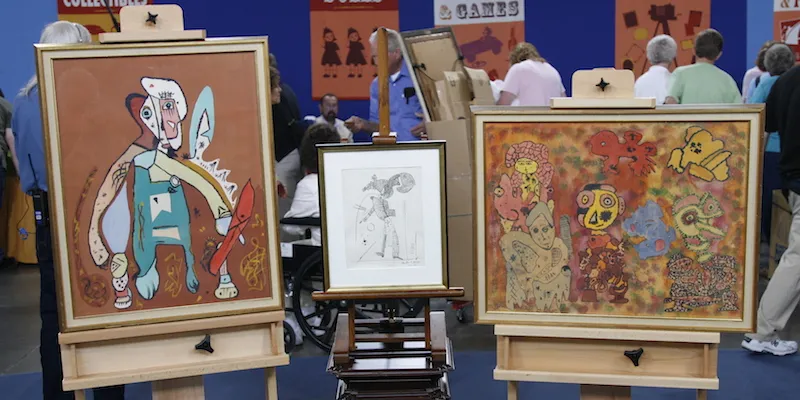Inside "Outsider Art"
In Tucson, appraisers saw three pieces of "Outsider Art"—but what is that?

Feb 26, 2007
At the 2006 ANTIQUES ROADSHOW in Tucson, Arizona, appraiser Colleene Fesko, of Skinner in Boston, was presented with three paintings by a lesser-known French artist named Gaston Chaissac, who lived from 1910 until 1964 and referred to himself as "Picasso in clogs." During Colleene's discussion with the owner of the paintings, she described Chaissac as someone who "really has all the characteristics of the classic outsider artist."
What did Colleene mean by the term "Outsider Art"?
Art Brut
After World War II, the French artist Jean Dubuffet coined the term Art Brut — which translates into English as "raw" or "rough" art—the first term used to describe outsider art. Dubuffet used the term to describe art created by people who had mental disorders, such as schizophrenia or other psychiatric illnesses, and were either institutionalized or had lives dominated by their illnesses. Dubuffet's awareness of these artists came in part from a book published in 1922 by a German doctor named Hans Prinzhorn. He collected thousands of works by psychiatric patients and published them in his book, Bildernerei der Geisteskranken (Artistry of the Mentally Ill).

The painter Gaston Chaissac was influenced by Pablo Picasso, pre-historic paintings, and children's art.
With other modern artists, such as André Breton, Dubuffet championed makers of Art Brut in the 1940s, including Chaissac. Dubuffet defined Art Brut this way: "Those works created from solitude and from pure and authentic creative impulses—where the worries of competition, acclaim, and social promotion do not interfere—are, because of these very facts, more precious than the productions of professions. After a certain familiarity with these flourishings of an exalted feverishness, lived so fully and so intensely by their authors, we cannot avoid the feeling that... cultural art in its entirety appears to be the game of a futile society, a fallacious parade."
A Broader Definition
But over the years, the term Outsider Art, which was first used by art critic Roger Cardinal, has been used in a looser way to include all those who are outside the tradition of academic art, regardless of their mental health. "Outsider Art is often created by self-taught artists who are working outside the mainstream of the fine-art tradition," Colleene says. "When you're studying art history, you follow the line from the Renaissance, to the Mannerist, Baroque, and Rococo periods. These artists aren't looking at that structured progression of Western art history. They don't study Michelangelo or Da Vinci, or the other masters. Their work is the external manifestation of what's going on in and outside of their personal experience."
This broader category of Outsider Art includes many subcategories that include folk art, naïve art, self-taught art, and visionary art. Many of these artists don't create in traditional ways. Chaissac sometimes held his paintbrush in his mouth, for example, and created art using wooden packing crates, wallpaper scraps, and driftwood. Another example of an outsider artist expanding the usual palette is American James Castle, from Idaho, who drew with a stick that spread a mixture of soot and saliva on found materials such as food containers and paper that came in the mail.
"One of the most compelling parts of Outsider Art is the individual purity of it," Colleene says. "It hasn't been contaminated by what other people think is good or bad or what is the right color scheme."
Chaissac as an Outsider
Like many outsider artists, Chaissac was largely self-taught. His major influences didn't come from the art world, but from children's art and pre-historic paintings. But Chaissac was different from many outsider artists, Colleene notes, in that he had a good amount of contact with mainstream artists, such as Dubuffet, as well as Otto Freundlich and Jeanne Kosnick-Kloss, neighbors of his in Paris who introduced him to modern art. Chaissac also earned some recognition in his lifetime—unusual for outsider artists. He became known internationally and his works were displayed in the Ekstrom Gallery in New York City.
Still, Chaissac spent most of his life penniless, partly because he rebelled against the Art Brut category that Dubuffet put him in, arguing that he wasn't mentally ill. "I quite simply dubbed my thingamabobs 'rustic modern paintings,'" he said. "Whereas Dubuffet astutely referred to his as Art Brut... His description caught on, but mine never got off the ground."
A Growing Popularity
Once the realm of mostly unknown and unpaid artists, Outsider Art has become quite collectible in the last 30 years. The Center for Intuitive and Outsider Art opened in Chicago in 1991, and since 1992, an Outsider Art Fair has been held annually in New York City. "While the style of the artists may be outside of the mainstream, their work is often marketed in a very mainstream way," Colleene says.
The prices placed on Outsider Art today can match much of what is considered Insider Art. Colleene valued Chaissac's three pieces from the 1950s and 1960s that turned up in Tucson at between $50,000 and $100,000. "His value keeps going up," Colleene told the owner. "Because he has that wonderful combination of childlike sophistication."


